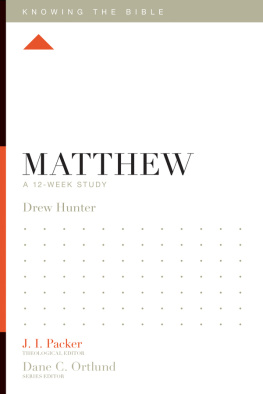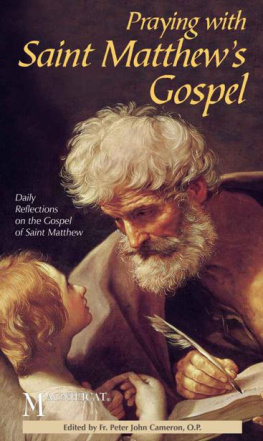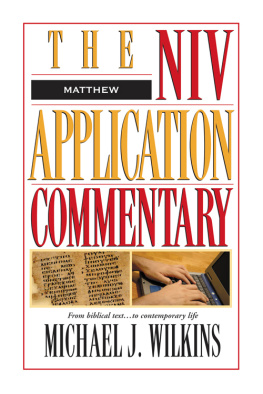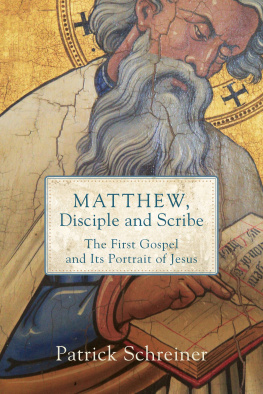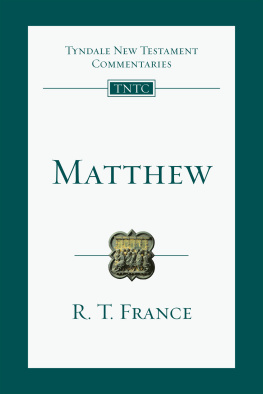Fulfilling the Law and the Prophets
Th e Prophetic Vocation of Jesus in the Gospel of Matthew
Matthew Anslow
foreword by David J. Neville
Fulfilling the Law and the Prophets
The Prophetic Vocation of Jesus in the Gospel of Matthew
Copyright 2022 Matthew Anslow. All rights reserved. Except for brief quotations in critical publications or reviews, no part of this book may be reproduced in any manner without prior written permission from the publisher. Write: Permissions, Wipf and Stock Publishers, W. th Ave., Suite , Eugene, OR 97401 .
Pickwick Publications
An Imprint of Wipf and Stock Publishers
W. th Ave., Suite
Eugene, OR 97401
www.wipfandstock.com
paperback isbn: 978-1-6667-3119-4
hardcover isbn: 978-1-6667-2341-0
ebook isbn: 978-1-6667-2342-7
Cataloguing-in-Publication data:
Names: Anslow, Matthew, author. | Neville, David J., foreword.
Title: Fulfilling the law and the prophets : the prophetic vocation of Jesus in the Gospel of Matthew / Matthew Anslow ; foreword by David J. Neville.
Description: Eugene, OR: Pickwick Publications, 2022 | Includes bibliographical references and index.
Identifiers: isbn 978-1-6667-3119-4 ( paperback ) | isbn 978-1-6667-2341-0 ( hardcover ) | isbn 978-1-6667-2342-7 ( ebook )
Subjects: LCSH: Bible. MatthewCriticism, interpretation, etc. | ProphecyChristianityBiblical teaching.
Classification: bs2575.2 a575 2022 ( print ) | bs2575.2 ( ebook )
07/15/22
Dedicated to Ashlee,
without whom this book
and my life as I know it
would be impossible.
Foreword
W ere one to compare Matthean studies to a gathering of specialists engaged in discussion and debate around a large seminar table, someone new to that conversation would need to have something worthwhile to say to gain a hearing. With this monograph, Matthew Anslow has earned a place at the Matthean seminar table. Thematically and methodologically, his study brings to light fresh perspectives on Matthews Gospel.
Fulfilling the Law and the Prophets is an intrinsically important and distinctive study of a relatively neglected feature of Matthews christology, namely, prophetic dimensions of Matthews narrative portrait of Jesus. Indeed, the prophetic vocation of Jesus is a central christological theme for Matthew, according to Anslow, which he demonstrates by means of detailed discussion of four key passages in the Gospel. Perhaps readers may already be inclined to regard Jesus temple disruption in Matt : and his tirade against scribes and Pharisees in Matthew in broadly prophetic terms, but Anslows argument that the beatitudes in Matt : compose prophetic speech and that Matthews account of Jesus table fellowship with tax agents and sinners (:) may be perceived as a prophetic act casts light from different angles on Matthews complex and multi-faceted depiction of the identity and significance of Jesus. In this connection, it is perhaps worth pointing out that although Anslows study focuses on Jesus as prophet within the Gospel according to Matthew, he does not reduce Matthews christology to Jesus prophetic role. By analogy with Anslows argument that Matthews presentation of Jesus prophetic vocation is multi-faceted by association with a range of Israelite prophetic traditions, Matthews depiction of Jesus as Israels prophet par excellence is but one facet of a multi-faceted christological portrait.
In methodological terms, Anslows study artfully and judiciously combines narrative-critical and socio-historical approaches. Independently, both approaches continue to be used fruitfully by Matthean scholars. In scholarly study of Matthews Gospel, Anslow may not be the first to combine narrative and socio-historical analysis, but his careful integration of both approaches, alongside attention to intertextual resonances with a range of biblical texts and motifs, contributes to an illuminating appraisal of decisive Matthean features.
For Anslow, Matthews prophetic christology addresses three principal issues related to his audiences concerns. Against the backdrop of social and ideological conflict with competing formative or proto-rabbinic Jewish antagonists as well as with Roman imperial pressures, Matthews presentation of Jesus as a prophetic figure who interprets the Torah in an authoritative way served to reassure his audience of its identity as people of a renewed covenant with the God of Israel. Depicting Jesus in prophetic terms also enabled Matthew to reinforce his audiences understanding of the God of Israel as the merciful judge of the world. Together, this conception of the identity of Matthews audience and its governing vision of God, facilitated by Matthews prophetic portrait of Jesus, implied and perhaps even generated a corporate self-understanding of a community of disciples with a renewed imperative to fulfil Israels vocation in the wider world. Perhaps such a vision has the compelling vibrancy to continue to inform what it means to be a disciple of Jesus in a conflicted world.
As one who learned much from Matt Anslows research as it came to fruition, I am delighted by the publication of this book, which will make his contribution to Matthean studies more widely accessible. For anyone interested in Matthews portrait of Jesus, I commend this study.
David J. Neville
St Marks National Theological Centre, Charles Sturt University
August, 2021
Preface
T he subject of prophecy has been of interest to me for some years now. This interest, far from being a purely intellectual curiosity, is the outworking of mainly practical and pastoral factors. Indeed, I can hardly ignore the autobiographical influences that have contributed to the following study.
I have been fortunate enough to have amassed a broad range of experience of the Christian church. I became a follower of Jesus as a teenager in a mildly-Charismatic Evangelical church, having grown up in a nominally Catholic family. I went on to study under and spend considerable time with Pentecostals and Catholics. I eventually embraced Neo-Anabaptism while attending a Uniting Church, a Mainline denomination created by the union of the Methodist, Presbyterian, and Congregationalist churches in Australia. I completed my doctoral studies in a university whose theology departments consisted of Uniting Church and Anglican colleges, and I have lectured in Pentecostal, Baptist, and Churches of Christ institutions. At the time of writing, I attend a Baptist Church two hours west of Sydney and am employed by the Uniting Church as a theological educator. As I say, I am fortunate to have been given the opportunity to spend time with Christians from all over the ecclesial and theological map, even if I do often feel like a proverbial mongrel.
I mention all of this because each of these diverse traditions has a notion and a language of prophecy, even if those notions are in many ways divergent and, in some cases, irreconcilable. Experience with a variety of traditions has led me to appreciate their diverse approaches to prophecy. I have, however, also grown to be critical of elements of those same approaches.
In truth, I have witnessed no shortage of what I can only call abuse under the guise of prophecy and prophetic ministry. In Pentecostal and Charismatic settings, such abuses are, sadly, all too common. I am sure some of those reading these words would have heard stories of, if not directly experienced, prophetic imperatives declaring, say, the end of a persons need for vital medication, calling for an obscene financial sacrifice for the benefit of a Christian ministry, or specifying a marriage partner. I could provide many further examples. And yet, I have seen amazing instances of this Pentecostal-style of prophecy which conveyed seemingly miraculous knowledge about some otherwise unknowable situation. Still, such instances do not cancel out those deeply problematic episodes of prophetic activity that I have witnessedepisodes that have left people traumatized, injured, and disillusioned.


